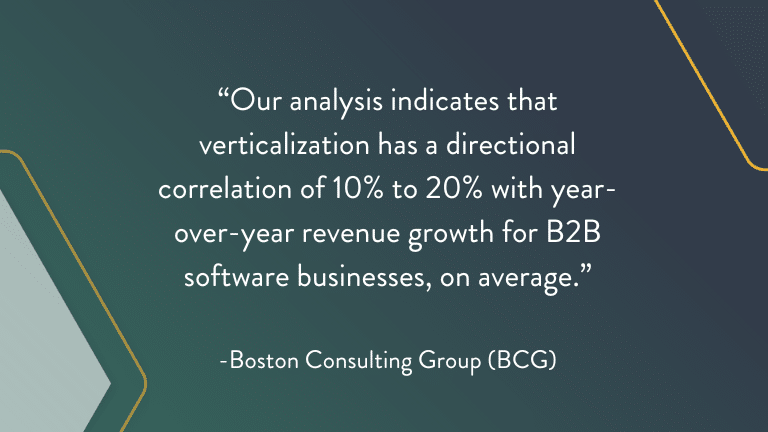The Missing Element of Go-to-Market Strategy

Don’t Think Only About Message Segmentation. Message Segmentation + Going Vertical = Expedited Growth
To be truly competitive in the B2B landscape, companies need to think beyond superficial segmentation and messaging. That’s not to say that understanding your customers and crafting targeted messages is not important, but what powers the Go-To-Market (GTM) strategy is the rigorous customization of products and services achieved by going vertical.
In other words, real measurable growth comes from tailoring products, services or operations to meet the specific needs and requirements of a particular industry or market vertical.
Let’s examine the main elements of a Go-To-Market strategy, and break down the critical distinction between messaging and true verticalization. This difference is key.

What do we mean by ‘vertical’ exactly? Take software firms, for example. B2B software firms are gaining sales growth by hyper focusing, not generalizing, on the customer needs in key industry verticals.
There are specific functions, apps and features that will appeal to customers in specific industries – such as financial services, retail, engineering, professional services, etc. The product or service has to match the needs and pain points of that specific customer.
“A range of industry-specific challenges, from various regulatory requirements to fragmented technology stacks, have led today’s B2B software buyers to expect vendor solutions that are custom-fit for their distinct needs. In response, software companies are increasingly ‘verticalizing’—adapting their products, marketing, sales, and ecosystems to specific industry use cases—rather than relying on the broad applicability of ‘horizontal‘ products.”
Boston Consulting Group (BCG)
When a company truly verticalizes its business – whether that be products or services – by industry, it creates both value for the customer and even more opportunities to grow sales. Companies tend to want to go horizontal and broad, but there is available growth in speaking directly to the specific customer needs in key verticals. This takes research and data analysis.
Who Is Going to Develop Segmentation and Verticalization Driven Sales Growth?
How well do you know your vertical customers’ pain points?
Below is a summation that explores the distinctions between segmentation and verticalization and makes a case for the prioritization of verticalization in B2B.
1. Beware the Illusion of Segmentation and Messaging:
–Segmentation is the Start. Knowing the target audience and crafting personalized messages is a foundational step in a GTM strategy. What some companies fail to understand is that it is just the beginning of a comprehensive approach.
–The Pitfall of Superficial Customization: Merely tweaking messaging and segmenting customers may create an illusion of “segmentation.” However, a strong GTM plan goes beyond the surface and customizes products and services for each core vertical.
2. The Power of True Industry Verticalization:
–Custom Fit Products and Services: True industry verticalization involves the deep customization of products and services that solve pain points, for each vertical. This goes beyond marketing language and addresses the unique requirements and challenges faced by customers in specific industries. Companies should embark on a true ideal customer profile data analysis and include customer and prospect interviews.
–Tailoring the Business DNA: Verticalization means embedding the characteristics of each industry into the DNA of your business. From product features to service delivery, this approach ensures that a company’s offerings are not just suitable but excel within each vertical.
3. Market Research and Customer Understanding:
–Bullseye on the Target Audience: Begin by understanding the characteristics of the ideal customer. What are their pain points, needs, and preferences? Conduct thorough market research to segment the audience based on industry, size, location, and other relevant factors.
–Being Sure About Buyer Personas: Develop detailed buyer personas that encompass the various roles and responsibilities within targeted companies. This granular understanding will guide messaging and product development efforts.
4. Segmentation for Precision Targeting:
–Implementing Industry Segmentation: Group target customers into industry verticals. Now a company can create tailored messages and solutions that resonate with the specific challenges faced by each vertical.
-Applying Account-Based Marketing (ABM): ABM is a targeted approach where marketing efforts are concentrated on a specific set of high-value accounts. By aligning marketing and sales efforts, ABM enhances personalization and increases the likelihood of success in B2B revenue growth.
A simple way to look at ABM is to: 1) choose a target list; 2.) decide if you want to build communication for 1:1, 1: few, or one to many; 3.) choose ABM software (if needed); and 4) map each customer account and identify all the personas you need to reach.
5. Customized Messaging that Gets Noticed:
–Vertical-Specific Messages = Engaged Audience: Tailor messaging to address the unique pain points, goals, and language of each industry vertical. This approach establishes a deeper connection with the audience, and demonstrates an understanding of their challenges.
–Value Proposition Alignment for Greater Granularity: Align value propositions with the specific needs of each vertical. Highlight how products or services solve industry-specific problems, making a company’s offerings more compelling to potential customers.
6. More on Product and Service Verticalization:
–Drilling Down on Customization and Specialization: Develop products and services that are specifically designed for each vertical. This level of customization positions a company’s offerings as indispensable solutions made for the unique requirements of target industries.
Some examples:
-An industrial tool supplier may also offer custom bandsaw blades to those customers that use them, or perhaps offer same-day delivery to customers within a 50 mile radius of a location.
-A cyber security software firm finds out that a specific vertical, like government accounts, need more than the usual IAM products. So the company offers a vertical-specific add-on for identity.
-A retail vertical needs fraud protection and credit card processing on a mobile device, and not just at a smart register at the sales checkout.
–Including Industry-Specific Features: Integrate features that cater to the distinct demands of each vertical. This not only enhances the utility of products but also reinforces the company’s commitment to addressing the specific needs of customers.
7. Sales Enablement to Advance Engagement:
–Vertical-Specific Sales Training: Equip the sales team with industry-specific knowledge and tools. This empowers them to engage in meaningful conversations with prospects, building credibility and trust within each vertical.
–Vertical-Specific Collateral: Provide sales teams with collateral tailored to each industry. This includes case studies, whitepapers, and success stories that demonstrate a company’s expertise and ability to deliver value in their vertical.
8. Iterative Optimization to Improve:
–Continuous Feedback Loop: Establish a feedback mechanism to gather insights from each vertical. Analyze customer feedback, market trends, and performance metrics to refine products, services, and messaging continually.
-Agile Adaptation to Stay Competitive: The business landscape evolves, and so should a company’s GTM strategy. Be agile in adapting to changes in customer needs, market dynamics, and industry trends.
9. Advisor or Partner Engagement as Part of Strategy:
–The Scale of GTM Execution: Crafting and executing a robust GTM strategy requires massive effort and resources. From research and segmentation to product development and sales enablement, the scope can be overwhelming for many companies.
–The Role of Advisors or Partners: Engaging with seasoned advisors or strategic partners can make the difference in a GTM plan. Their years of experience and on-the-ground insights are what help companies navigate the complexities of strategy development and execution.
–Strategic Guidance: Advisors provide strategic guidance based on industry knowledge and market trends. This is important to make sure that a company allocates their resources in the best places, for the best outcome.
–Execution Support: Partners can also assist in the sales and marketing execution phase, providing hands-on support in implementing the GTM strategy. This collaborative approach often accelerates the timeline to market, creates revenue growth and optimizes the overall effectiveness of your plan.
–Mitigating Risks: Advisors or partners help identify potential pitfalls and risks in your GTM strategy, and can offer proactive solutions to mitigate challenges and save time and money.
Conclusion:
In B2B, a successful Go-To-Market strategy is not only about understanding your customers and creating messages to speak to them. It’s fundamentally about solving real pain points and verticalizing your business by customer industry. The deep customization of products and services by vertical can spur growth.
Recognizing the difference between surface-level segmentation and true verticalization is key to building a resilient GTM plan. By combining customer knowledge, verticalization, and external expertise, B2B companies can establish a solid foundation for success. This lays the groundwork for sustained growth, industry leadership, and longtime customers.
Craig Group is a revenue-growth advisor to PE-Backed Middle Market Portfolio Companies.